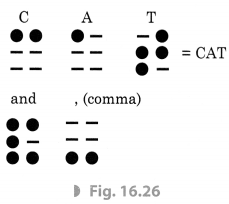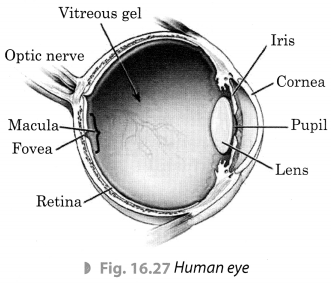Class 8th physics //Chapter Light//Long Questions & Answers//कक्षा 8वीं भौतिकी // अध्याय प्रकाश // दिर्घ प्रश्न और उत्तर
| Long Questions & Answers |
|---|
Question 1. Write a short note on Braille system. Braille system has 63 dot patterns or characters. Each character represents a letter, a combination of letters, a common word or a grammatical sign. Dots are arranged in cells of two vertical rows of three dots each. Patterns of dots to represent some English letters and some common words are shown in Fig. 16.26. Question 3. Write a note on ‘The Human Eye’.
Question 4. Write the ways to protect your eyes.
Question 5. Explain some common eye defects in human. (i) Cataract: A cataract is a clouding of the lens in the eye leading to a decrease in vision. It can affect one or both eyes. Often it develops slowly. Symptoms may include faded colours, blurry vision, halos around light, trouble with bright lights, and trouble seeing at night. This may result in trouble driving, reading, or recognising faces. Cataracts are the cause of half of blindness and 33% of visual impairment worldwide. Cataract is treated by replacing the opaque lens with a new artificial lens. (ii) Myopia: Near-sightedness or myopia, is the most common refractive error of the eye. Myopia occurs when the eyeball is too long, relative to the focusing power of the cornea and lens of the eye. This causes light rays to focus at a point in front of the retina, rather than directly on its surface. It can be corrected using spectacles made of concave lens. (iii) Hypermetropia: Hypermetropia or long-sightedness occurs when eyeball is too short or the cornea or crystalline lens does not refract the light enough. This lead to formation of the image of a nearby object behind the retina. A hypermetropic person may have blurred vision when looking at objects close to them, and clearer vision when looking at objects in the distance. By placing a convex (plus powered) lens in front of a hypermetropic eye, the image is moved forward and focuses correctly on the retina. (iv) Astigmatism: It is a defect in the eye or in a lens caused by a deviation from spherical curvature, which results in distorted images, as light rays are prevented from meeting at a common focus. It can be corrected by using a convex lens or concave lens or both. |
Hindi Medium
| दिर्घ प्रश्न और उत्तर |
|---|
| प्रश्न 1. ब्रेल प्रणाली पर एक संक्षिप्त टिप्पणी लिखिए।
उत्तर:- दृष्टिबाधित व्यक्तियों के लिए सबसे लोकप्रिय संसाधन ब्रेल है। ब्रेल प्रणाली लुई ब्रेल द्वारा विकसित की गई थी। वे स्वयं दृष्टिबाधित व्यक्ति थे। सामान्य भाषाओं, गणित और वैज्ञानिक संकेतन के लिए ब्रेल कोड है। कई भारतीय भाषाओं को ब्रेल प्रणाली का उपयोग करके पढ़ा जा सकता है। ब्रेल प्रणाली में 63 डॉट पैटर्न या वर्ण होते हैं। प्रत्येक वर्ण एक अक्षर, अक्षरों के संयोजन, एक सामान्य शब्द या व्याकरणिक चिह्न का प्रतिनिधित्व करता है। डॉट्स प्रत्येक तीन डॉट्स की दो लंबवत पंक्तियों की कोशिकाओं में व्यवस्थित होते हैं। कुछ अंग्रेजी अक्षरों और कुछ सामान्य शब्दों को दर्शाने के लिए बिंदुओं के पैटर्न चित्र 16.26 में दिखाए गए हैं। 
ये पैटर्न जब ब्रेल शीट पर उकेरे जाते हैं तो दृष्टिबाधित व्यक्तियों को स्पर्श करके शब्दों को पहचानने में मदद मिलती है। उन्हें स्पर्श करना आसान बनाने के लिए, बिंदुओं को थोड़ा ऊपर उठाया जाता है। दृष्टिबाधित लोग अक्षरों से शुरुआत करके, फिर विशेष वर्णों और अक्षरों के संयोजन से ब्रेल प्रणाली सीखते हैं। तरीके छूकर पहचान पर निर्भर करते हैं। हर किरदार को याद रखना होता है। ब्रेल लिपि को हाथ से या मशीन से बनाया जा सकता है। टाइपराइटर जैसे उपकरण और प्रिंटिंग मशीनें अब विकसित हो चुकी हैं। प्रश्न 2. प्रकाश के परिक्षेपण की परिघटना को स्पष्ट कीजिए। उत्तर:- प्रिज्म जैसे पारदर्शी माध्यम से गुजरने पर सफेद प्रकाश के अलग-अलग रंगों में विभाजित होने की घटना को फैलाव के रूप में परिभाषित किया गया है। जब श्वेत प्रकाश को प्रिज्म से गुजारा जाता है, तो वह सात रंगों में विभाजित हो जाता है। यह देखा गया है कि रंग निम्नलिखित क्रम में हैं: बैंगनी (वी), इंडिगो (आई), नीला (बी), हरा (जी), पीला (वाई), नारंगी (ओ) और लाल (आर)। रंगों के क्रम को संक्षिप्त नाम VIBGYOR द्वारा याद किया जा सकता है। इस रंगीन पट्टी को श्वेत प्रकाश का स्पेक्ट्रम कहते हैं। प्रश्न 3. 'मानव नेत्र' पर एक टिप्पणी लिखिए। उत्तर:- आंख एक इंद्रिय अंग है जो हमें अपने आसपास की दुनिया को देखने में सक्षम बनाता है। यह आकार में लगभग गोलाकार होता है।  पहला भाग जो बाहर की ओर उभरा होता है उसे 'कॉर्निया' कहते हैं। यह आंख की रक्षा करता है। कॉर्निया के पीछे आंख का रंगीन हिस्सा, आईरिस मौजूद होता है। यह पुतली के आकार को नियंत्रित करता है। पुतली कॉर्निया में एक छोटा सा उद्घाटन है जो प्रकाश को आंख में प्रवेश करने की अनुमति देता है। परितारिका के पीछे नेत्र लेंस मौजूद होता है जो उत्तल लेंस होता है। यह प्रकाश किरणों को मोड़कर प्रतिबिम्ब को रेटिना पर केंद्रित करता है। रेटिना आंख की आंतरिक पिछली सतह है जो छवि बनाने के लिए एक स्क्रीन के रूप में कार्य करती है। यह प्रकाश के प्रति संवेदनशील है। रेटिना पर बनने वाले प्रतिबिम्ब की अनुभूति को ऑप्टिक तंत्रिका द्वारा मस्तिष्क तक पहुँचाया जाता है। ऑप्टिक तंत्रिका आंख और के बीच संबंध है। प्रश्न 4. आँखों की सुरक्षा के उपाय लिखिए। उत्तर:- आंखें बहुत ही नाजुक अंग हैं जो हमें इस रंगीन दुनिया को देखने में सक्षम बनाती हैं। इसलिए हमें अपनी आंखों की रक्षा करनी चाहिए और उनकी उचित देखभाल करनी चाहिए। आंखों की सुरक्षा के उपाय निम्नलिखित हैं: 1. पढ़ते या लिखते समय हमेशा सीधे बैठें। 2. चलते या लेटते समय कभी न पढ़ें। 3. अपनी आंखों को बार-बार साफ पानी से धोएं। 4. कभी भी मंद या बहुत तेज रोशनी में न पढ़ें। 5. अपनी आंखों को कभी भी हाथों से न रगड़ें। 6. किताब को कभी भी अपनी आंखों के ज्यादा पास न लाएं। 7.विटामिन ए से भरपूर खाद्य पदार्थ खाएं। प्रश्न 5. मानव में कुछ सामान्य नेत्र दोषों की व्याख्या कीजिए। उत्तर:- कुछ नेत्र रोग हैं: (i) मोतियाबिंद: मोतियाबिंद आंख में लेंस का एक बादल है जिससे दृष्टि में कमी आती है। यह एक या दोनों आंखों को प्रभावित कर सकता है। अक्सर यह धीरे-धीरे विकसित होता है। लक्षणों में फीके रंग, धुंधली दृष्टि, प्रकाश के चारों ओर प्रभामंडल, तेज रोशनी में परेशानी और रात में देखने में परेशानी शामिल हो सकते हैं। इसके परिणामस्वरूप वाहन चलाने, पढ़ने या चेहरों को पहचानने में समस्या हो सकती है। मोतियाबिंद दुनिया भर में आधे अंधेपन और 33% दृश्य हानि का कारण है। अपारदर्शी लेंस को एक नए कृत्रिम लेंस के साथ बदलकर मोतियाबिंद का इलाज किया जाता है। (ii) मायोपिया: निकट-दृष्टि या मायोपिया, आंख की सबसे आम अपवर्तक त्रुटि है। मायोपिया तब होता है जब नेत्रगोलक बहुत लंबा होता है, जो कॉर्निया और आंख के लेंस की फोकस करने की शक्ति के सापेक्ष होता है। इससे प्रकाश किरणें सीधे उसकी सतह पर नहीं बल्कि रेटिना के सामने एक बिंदु पर केंद्रित होती हैं। इसे अवतल लेंस से बने चश्मे से ठीक किया जा सकता है। (iii) हाइपरमेट्रोपिया: हाइपरमेट्रोपिया या दूरदर्शिता तब होती है जब नेत्रगोलक बहुत छोटा होता है या कॉर्निया या क्रिस्टलीय लेंस प्रकाश को पर्याप्त रूप से अपवर्तित नहीं करता है। इससे रेटिना के पीछे किसी पास की वस्तु का प्रतिबिम्ब बनता है। एक हाइपरमेट्रोपिक व्यक्ति की दृष्टि धुंधली हो सकती है जब वे अपने पास की वस्तुओं को देखते हैं, और दूर की वस्तुओं को देखते समय स्पष्ट दृष्टि रखते हैं। हाइपरमेट्रोपिक आंख के सामने उत्तल (प्लस पावर्ड) लेंस रखकर, छवि आगे बढ़ जाती है और रेटिना पर सही ढंग से केंद्रित होती है। (iv) दृष्टिवैषम्य: यह आंख में या लेंस में एक दोष है जो गोलाकार वक्रता से विचलन के कारण होता है, जिसके परिणामस्वरूप विकृत छवियां होती हैं, क्योंकि प्रकाश किरणों को एक सामान्य फोकस पर मिलने से रोका जाता है। इसे उत्तल लेंस या अवतल लेंस या दोनों का उपयोग करके ठीक किया जा सकता है। |


